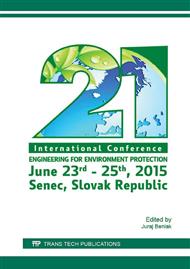p.55
p.63
p.69
p.79
p.89
p.95
p.103
p.109
p.115
The Effectiveness Criterion for Densification of Wood Waste
Abstract:
Densification process of biomass to the form of high-grade solid biofuel (briquette or pellet) is influenced by amount of technological factors. Size fraction and moisture content of raw material have the most importance. The densification process may be describing by complicated mathematical models based on behaviour of pressed particular matter. Therefore it is complicated to energy optimize the process. This paper deals with a methodology for determining the compressibility for pine sawdust on the basis of experiments. It also specifies the effectiveness criterion for biomass densification in order to optimize the densification process in terms of energy input. The experiments were performed in two stages. The first stage was an experimental investigation of the influence of size fraction and moisture content on the final compressibility of pine sawdust. High-pressure binderless densification of pine processing residues in the form of sawdust was studied. A piston-and-die process was used to produce densified briquettes under 20 °C temperature and at pressure up to 159 MPa. The results show the behaviour of the pressure load when the parameters of the particulate matter are changed. In the second stage, the experiments were evaluated and optimized to achieve minimum energy input of the process and a maximum degree of densification. For this purpose the Effectiveness Criterion for Densification was designed
Info:
Periodical:
Pages:
89-94
Citation:
Online since:
April 2016
Authors:
Keywords:
Price:
Сopyright:
© 2016 Trans Tech Publications Ltd. All Rights Reserved
Share:
Citation:


